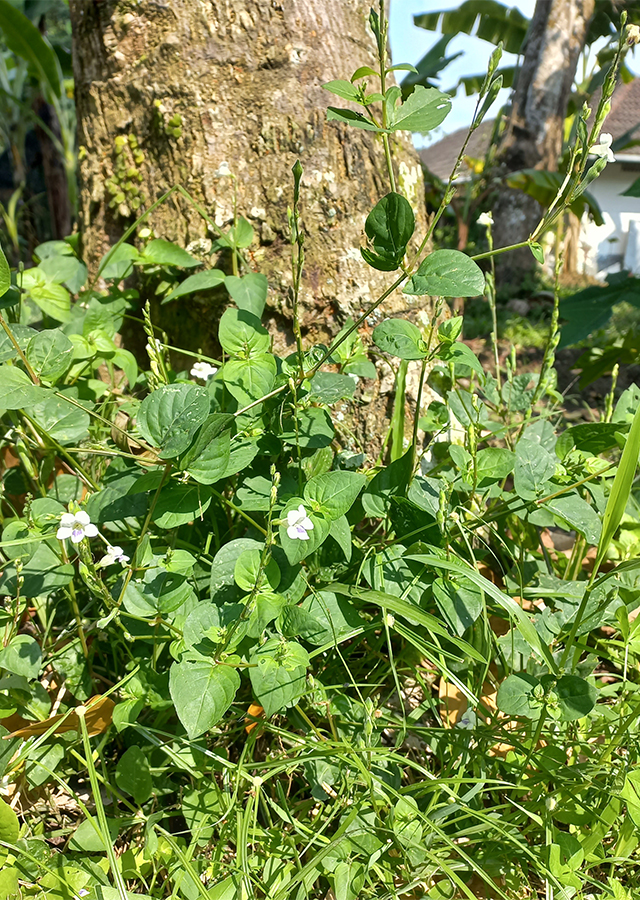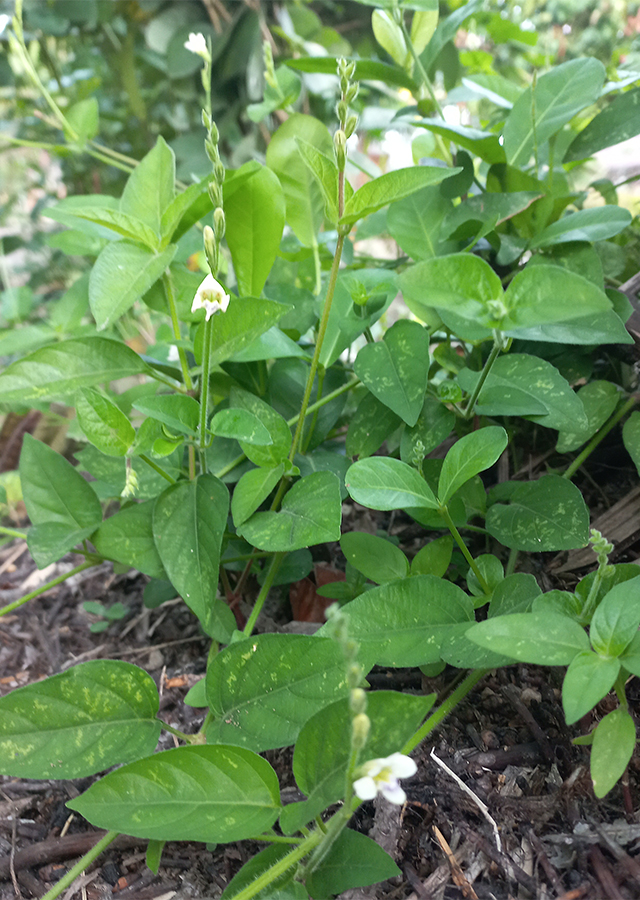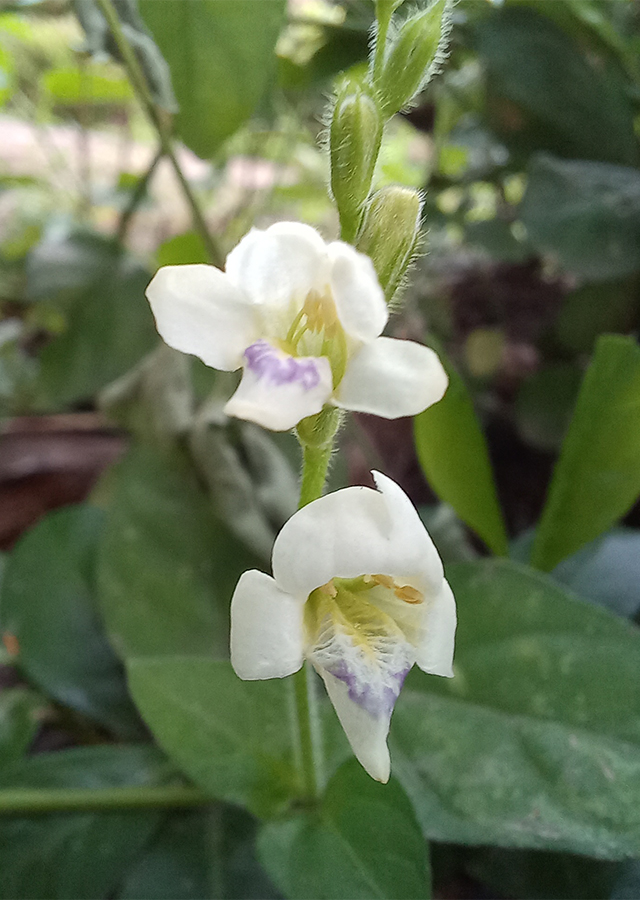Chinese Violet
Asystasia gangetica (L.) T.Anderson
Acanthaceae
Location in our garden
Beneficial Weed



Synonym
Justicia gangetica L.
Ruellia gangetica (L.) R.Br.
Habitus
Herbaceous. A perennial plant with weak stems 1 m or longer which sprawl along the ground
Part Used
Leaves
Flowers
Sap
The Whole Plant
Growing Requirements
Full Sunshine
Need Shade
Drought Resistant
Habitat
Wetland
Riverbanks
Forest
Roadside
Shrublands
Grassland
Terrestrial
Overview
The species A. gangetica is native to tropical Malaysia, India, and Africa, but has been introduced into tropical areas in North, Central and South America, Hawaii, West Indies, and Australia as an ornamental herb and eventually escapes into natural and disturbed areas. The plant is harvested from the wild for local use as a food and medicine. It is sometimes sold in local markets during the rainy season.
Vernacular Names
Coromandel (Spanish), Herbe le rail (French), Kuan ye shi wan cuo (Chinese), Rumput nyonya (Malay), Creeping foxglove (South Africaan), Baya (Thai).
Agroecology
Found growing on roadsides and riverbanks, in semi-waterlogged areas as well as well drained cultivated areas. Grows best in the humid areas of the tropics. In parts of Africa, where it has become naturalized, it grows in areas where the mean annual rainfall is in the range 1,200 - 2,100 mm. An easily grown plant, preferring a relatively dry soil and a position in full sun or partial shade. Thrives on sedentary soils, coastal alluvium, sandy loams and clays. Plants can succeed in peat soils with 85% organic matter and a pH as low as 3.5 - 4.5.
Morphology
- Stems - quadrangular.
- Leaves - opposite; blades simple, with numerous linear cystoliths on the upper surface, the secondary veins conspicuous; stipules absent.
- Flowers - bisexual, zygomorphic, arranged in spikes on axillary branches. Calyx green, 5-7 mm long, the sepals lanceolate; corolla asymmetrically funnel-shaped, light yellow or pale violet, 2.3-5 cm long, with glandular hairs on the outer surface; stamens and pistil inserted on the floral tube.
- Fruits - ellipsoid or club-shaped, 2-2.5 cm long, light brown when ripe, densely covered with glandular hairs.
- Seeds - 2-4 light brown, with irregular margins, lenticular.
Cultivation
Propagated by seeds, single-node cuttings and division of rooted stems.
Chemical Constituents
Alkaloids, tannins, steroid aglycans, saponins, flavonoids, triterpenoids, biflavone glycoside - apigenin 7-O-glucosyl (3'-6") luteolin 7"-O-glucoside, 5,11-epoxymegastigmane glucoside (asysgangoside), anthraquinone, oil volatile (hexadecanoic acid, n-hexadecanoic acid, phytol, and 9,12,15-octadecanoic acid).
Traditional Medicinal Uses
- The leaf extract has been shown to relax histamine-precontracted trachial strips and to exhibit antiinflammatory activity.
- The juice of the plant, combined with lime and onion juice, is recommended for dry coughs with an irritated throat and discomfort in the chest.
- The sap of the plant is used as a vermifuge and is applied externally to swellings and rheumatic joints. Sap of the leaf is put up the nostrils to stop a nose-bleed, and is also used as an embrocation on a sore neck.
- A leaf-decoction is used in the treatment of fever-aches, epilepsy, stomach-pains, heart-pains and urethral discharge.
- The leaves and flowers are used as intestinal astringent. The leaves are used in the treatment of asthma,
- The plant is popularly used in many parts of Africa to ease childbirth. It is boiled and the infusion mixed with peppers then used as a syringe during the later months of pregnancy in order to ease childbirth pains.
- In Congo leaf-sap is placed on the stomach of women in childbirth to facilitate labour.
Part Used
Reference Sources
- Stuartxchange. 2019. Philippine Medicinal Plants: Asistasia. http://www.stuartxchange.org/Asistasia.html. 08-03-22.
- Flora Fauna Web. 2021. Asystasia gangetica (L.) T. Anderson. https://www.nparks.gov.sg/florafaunaweb/flora/1/7/1703. 08-03-22.
- CAB International. 2022. Invasive Species Compendium: Asystasia gangetica (chinese violet). https://www.cabi.org/isc/datasheet/7641#tosummaryOfInvasiveness. 08-03-22.
- Useful Tropical Plants Database. 2021. Asystasia gangetica. http://tropical.theferns.info/viewtropical.php?id=Asystasia+gangetica. 08-03-22.


